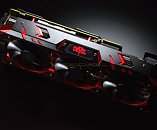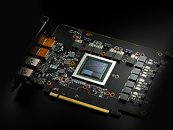- Joined
- Oct 9, 2007
- Messages
- 47,682 (7.42/day)
- Location
- Dublin, Ireland
| System Name | RBMK-1000 |
|---|---|
| Processor | AMD Ryzen 7 5700G |
| Motherboard | Gigabyte B550 AORUS Elite V2 |
| Cooling | DeepCool Gammax L240 V2 |
| Memory | 2x 16GB DDR4-3200 |
| Video Card(s) | Galax RTX 4070 Ti EX |
| Storage | Samsung 990 1TB |
| Display(s) | BenQ 1440p 60 Hz 27-inch |
| Case | Corsair Carbide 100R |
| Audio Device(s) | ASUS SupremeFX S1220A |
| Power Supply | Cooler Master MWE Gold 650W |
| Mouse | ASUS ROG Strix Impact |
| Keyboard | Gamdias Hermes E2 |
| Software | Windows 11 Pro |
PowerColor teased its first Radeon RX Vega series graphics card, under its flagship Red Devil branding. The company could use this common board design for both RX Vega 64 and RX Vega 56 SKUs. It combines a custom-design, triple-slot, triple-fan cooling solution, with a semi-custom design PCB. The cooler is an upscale of the company's RX 580 Red Devil, with a massive 2.5-slot thick aluminum fin-stack heatsink, which draws heat from the "Vega 10" GPU and a base-plate conveying heat from the VRM MOSFETs surrounding it, ventilated by a trio of 100 mm fans.
PowerColor's PCB for this card is a variation of AMD's reference "Vega 10" board, in that it's slightly taller towards the front. The company went with two each of DisplayPort and HDMI connectors, instead of the standard three DP + one HDMI layout. The VRM is the same 12-phase setup from the reference-design PCB, with PowerColor sticking to International Rectifier IR6894 and IR6211DirectFETs, and IR3598 phase-doublers, while customizing the chokes. The PCB is enlarged height-wise to give easy access to the BIOS switch. Two inverted 8-pin PCIe power inputs are located toward the end. Given how heavily this board is based on the reference PCB, it remains to be seen if fan idle-power off is featured. PowerColor is expected to launch the RX Vega 64 Red Devil and RX Vega 56 Red Devil before Holiday.


View at TechPowerUp Main Site
PowerColor's PCB for this card is a variation of AMD's reference "Vega 10" board, in that it's slightly taller towards the front. The company went with two each of DisplayPort and HDMI connectors, instead of the standard three DP + one HDMI layout. The VRM is the same 12-phase setup from the reference-design PCB, with PowerColor sticking to International Rectifier IR6894 and IR6211DirectFETs, and IR3598 phase-doublers, while customizing the chokes. The PCB is enlarged height-wise to give easy access to the BIOS switch. Two inverted 8-pin PCIe power inputs are located toward the end. Given how heavily this board is based on the reference PCB, it remains to be seen if fan idle-power off is featured. PowerColor is expected to launch the RX Vega 64 Red Devil and RX Vega 56 Red Devil before Holiday.


View at TechPowerUp Main Site
Last edited:





